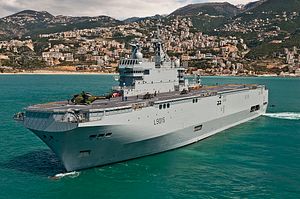In 2014, France determined that it would avert plans to sell two of its Mistral-class amphibious assault ships that were originally bound for sale to Russia. The decision was spurred, in part, by pressure from French allies, including the United States, who saw a sale of a complex naval asset to Russia in the wake of its support of anti-government Ukrainian rebels as inappropriate. The deal between France and Russia had originally been concluded in 2011, and was canceled last year, leaving the French with two Mistrals in hand, miffed at the lack of an eager customer. The Franco-Russian agreement for the Mistral sale reached a final price of $1.37 billion euros for the two ships.
Two weeks ago, reports emerged in the Taiwan-based China Times, citing Duowei News, that China may be the latest customer for the French Mistral vessels. The report further noted that China’s People’s Liberation Army’s microblog noted a French task force visit to France. The French had sent two warships, including the Dixmude, the final Mistral-class ship built for the French navy. The French naval task force also comprised the Aconit, a La Fayette-class frigate. The report further noted that this visit marked the first time that a French Mistral docked at a Chinese port. All of this activity takes place amid the political difficulty of putting together a sale given the European Union’s still-in-place arms embargo against China–a retaliatory move for Beijing’s suppression of the Tiananmen Square protests of 1989.
The Mistral-class amphibious assault ship, named for the frigid, northwesterly wind that sweeps out from the French coast into northern Mediterranean waters, is well-equipped for island warfare, and littoral projection and command. For China, an investment in an advanced off-the-shelf amphibious assault vessel would be sensible given current tensions over disputed islands and sea features in the East and South China Seas. The Mistral is also capable of assisting in humanitarian assistance and disaster relief (HADR) scenarios, with extensive hospital facilities on board.
The French had further modified the Mistrals that were Russia-bound to accommodate the Russian Navy’s Ka-27 Helix helicopters. China also operates the Ka-27, and the more advanced Ka-28. China has both the use scenarios and the military infrastructure necessary to make effective use of the ships. China could additionally apply its own domestic know-how in modifying the Mistral to serve as a potent anti-submarine warfare (ASW) platform. The Mistral‘s hangar deck would let the PLA-N conduct considerably less constrained helicopter surveillance operations than its own Jiangdao-class Type 056A frigates.
Of course, none of this, including the tenuous rumors picked up by some sources, mean that China is anywhere near finalizing a purchase of the two Mistrals that never made it into the Russian navy. The possibility of China snapping up the Mistrals on the open market will surely spark the same sort of concern in the United States as the prospect of the Russian sale did in early 2014. Already, commentators are making the case that it might make sense for the United States to pluck these ships off the market, lest China add two capable ships to its growing and increasingly modern navy.
As unlikely as a sale might be, watch this space. The fate of these two free-floating French Mistrals could end up further tilting the balance in Asia should China purchase them.

































